Understanding the Real Clean Eating Definition
In a world of ever-changing dietary trends, clean eating has emerged as a term that many people recognize but few fully understand. While often promoted as a health-forward approach, the clean eating definition can vary significantly depending on who you ask. Some interpret it as a raw food-only plan, while others see it as a low-carb philosophy. However, from a nutritional science perspective, clean eating refers to consuming whole, minimally processed foods that are free from artificial ingredients, refined sugars, and unhealthy fats. It is a flexible, long-term approach to eating that prioritizes health, balance, and nutritional integrity.
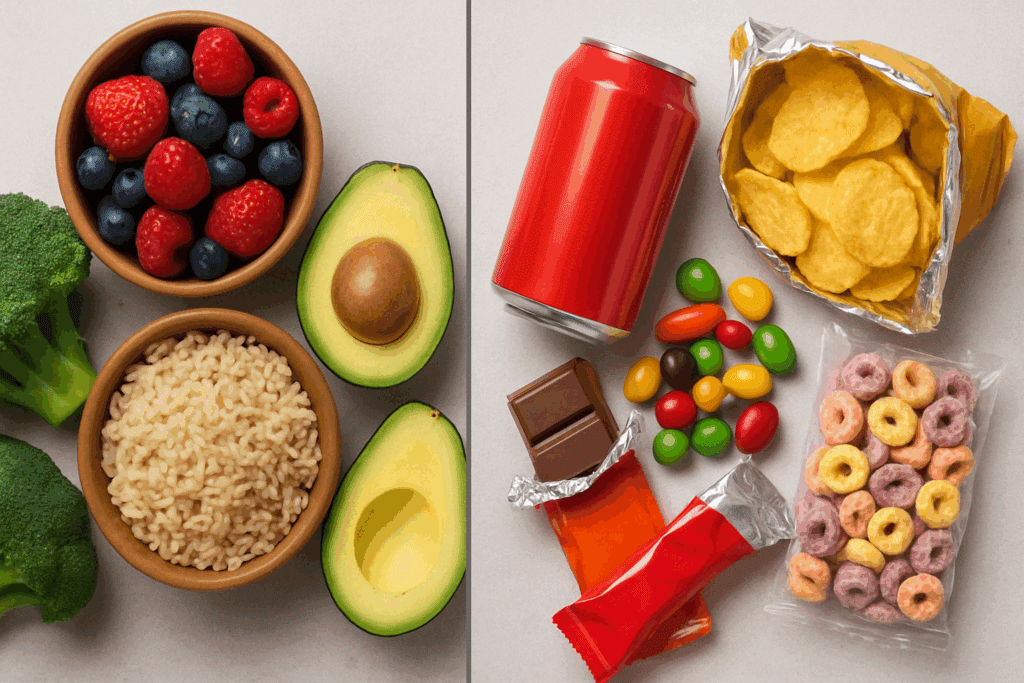
To truly understand what eating clean means, it’s important to look beyond the social media trends and return to fundamentals. Eating clean means choosing foods that are as close to their natural state as possible, such as fresh vegetables, fruits, legumes, nuts, whole grains, and lean proteins. It also means minimizing or eliminating processed snacks, sugary drinks, and overly refined carbohydrates. Clean eating is not about labeling foods as morally “good” or “bad”—it’s about making informed choices that support your health goals without becoming obsessive or restrictive.
In essence, clean eating invites us to be more mindful about what we consume and how we nourish our bodies. It offers a science-backed, sustainable model of nutrition that aligns with evidence-based health principles. By focusing on nutrient-dense foods and reducing processed products, clean eating supports everything from metabolic function and energy levels to gut health and chronic disease prevention.
You may also like: How a Whole Foods Diet Supports Sustainable Weight Loss: Expert Tips for Eating Whole Foods to Lose Weight Safely
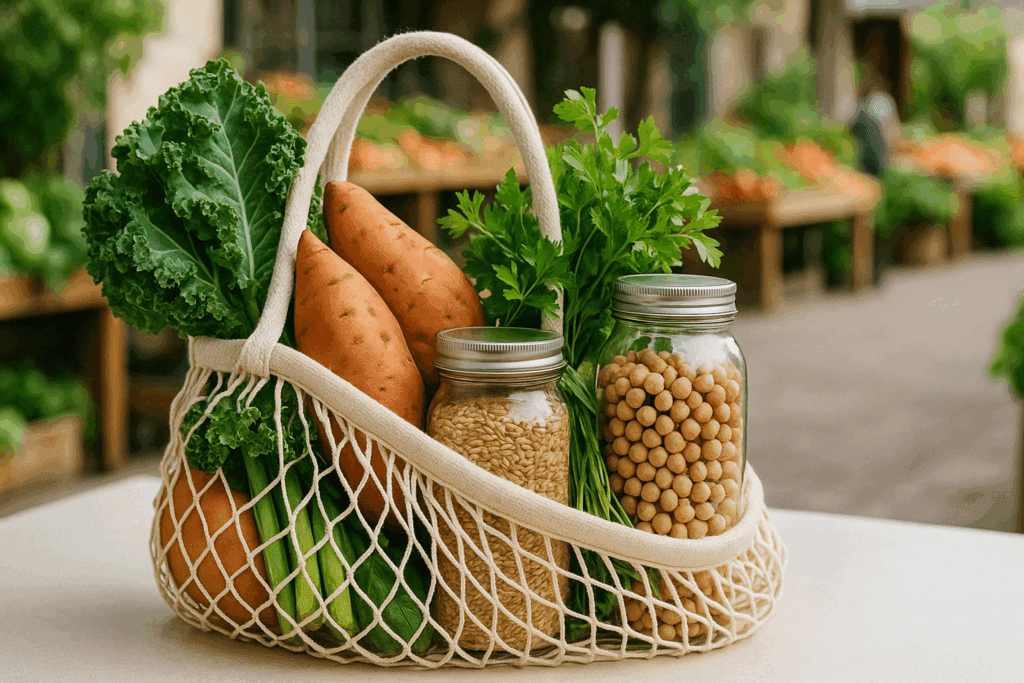
What Is Clean Food? Clarifying a Common Misconception
When asking what clean food is, many people are surprised to learn that there is no official or universally recognized definition. The term doesn’t refer to cleanliness in the literal sense but rather to the idea that food should be minimally altered from its original form. Clean food includes whole vegetables and fruits, whole grains like oats and quinoa, legumes, seeds, and foods that are free from added sugars, artificial preservatives, flavorings, or synthetic chemicals. The cleanest foods are those that are closest to nature—unrefined, unprocessed, and nutrient-rich.
A clean food list might include foods such as leafy greens, berries, nuts, sweet potatoes, lentils, salmon, and avocado. These foods not only provide essential nutrients like fiber, omega-3s, and antioxidants, but they also support the body’s natural detoxification systems and promote overall vitality. Unlike restrictive diets that cut out entire food groups or enforce rigid calorie rules, clean eating provides a flexible framework based on nutritional quality.
Importantly, clean eating does not require eliminating all packaged or prepared foods. For example, canned beans without additives, frozen vegetables, or plain Greek yogurt can all be part of a clean eating food list. The goal is to read labels carefully and understand what’s in your food. When we prioritize the cleanest foods available, we nourish our bodies with intention and reduce our exposure to inflammatory compounds and nutrient-poor fillers.
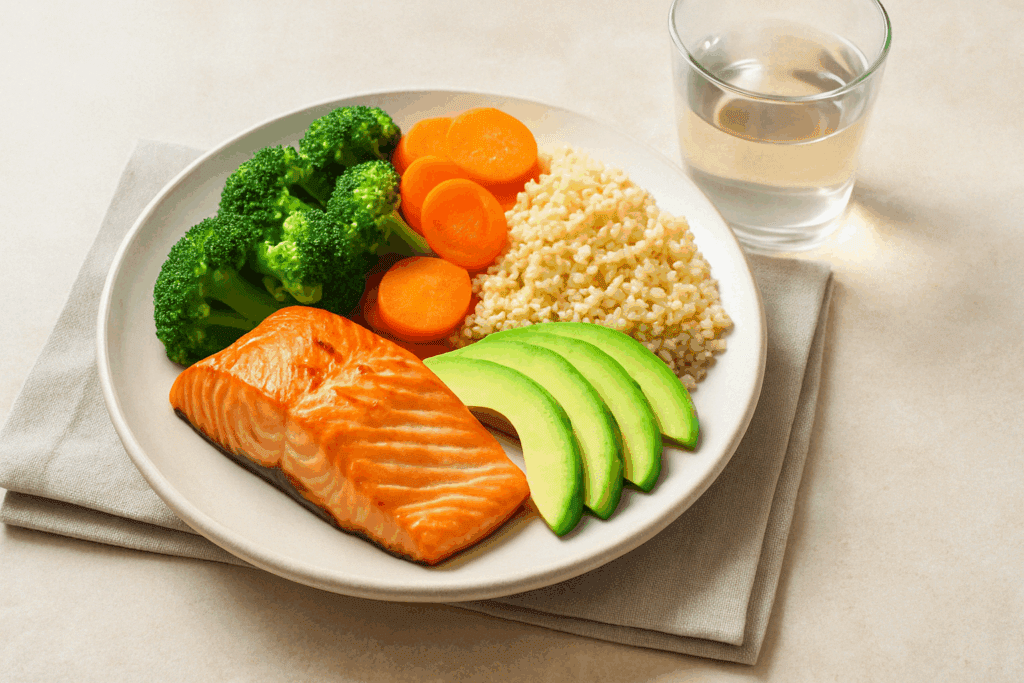
Clean Eating Foods That Build a Healthy Foundation
A central tenet of clean eating is incorporating a diverse range of whole, unprocessed foods into your daily meals. Clean eating foods include colorful vegetables, seasonal fruits, plant-based proteins, and healthy fats that contribute to balanced nutrition. These foods are nutrient-dense, meaning they deliver a high amount of vitamins, minerals, and antioxidants relative to their calorie content. This nutritional density is what makes clean eating a powerful tool for long-term wellness.
One of the biggest strengths of clean eating is its emphasis on variety. Each type of clean food provides unique benefits. For instance, cruciferous vegetables like broccoli and Brussels sprouts support liver function and hormonal balance, and whole foods like flaxseeds and walnuts deliver heart-healthy omega-3 fatty acids. Legumes such as black beans and lentils offer plant-based protein and fiber that help stabilize blood sugar and promote satiety. Whole grains like brown rice and farro fuel the body with complex carbohydrates that digest slowly and keep energy levels stable.
When curating a clean food list, aim for a balance across food groups. This includes lean proteins (plant or animal-based), healthy fats (like olive oil, nuts, and seeds), fiber-rich produce, and hydrating fluids. The cleanest foods are those without a long list of ingredients—ideally, they have just one. An apple is clean. A bag of fruit snacks made with added sugar, dyes, and preservatives is not. This simple guideline can help you quickly assess whether a food fits into a clean eating plan.
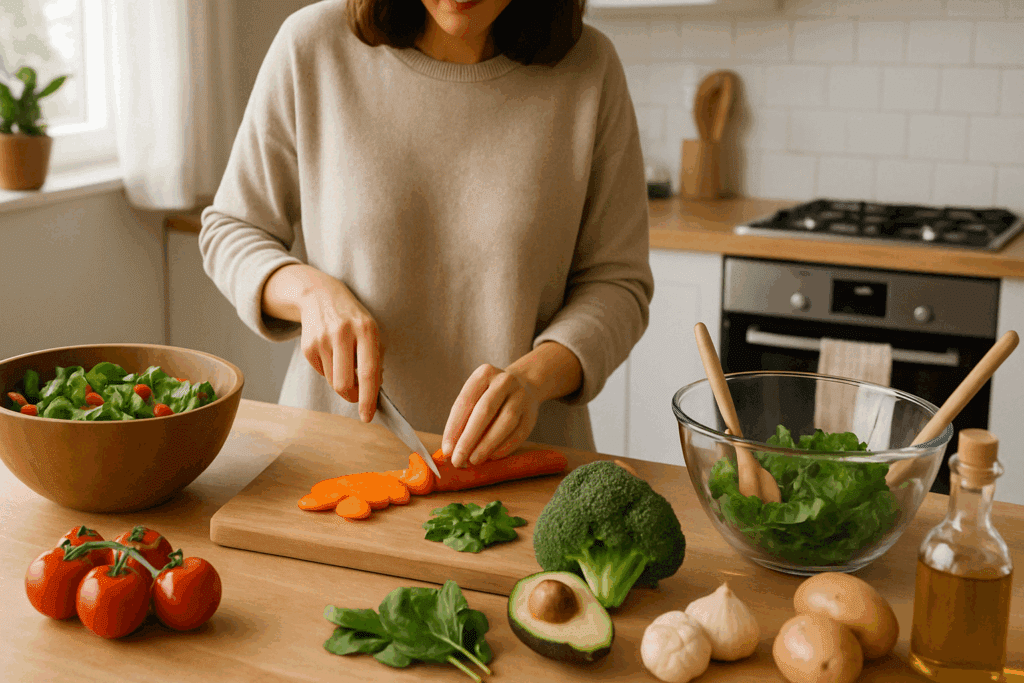
The Clean Eating Meaning in Everyday Practice
While the clean eating meaning may seem clear in theory, applying it in daily life requires intentionality and flexibility. Clean eating is not about being perfect or never enjoying a favorite treat. Instead, it encourages a consistent commitment to choosing high-quality foods the majority of the time. This means shopping with a plan, preparing meals at home more often, and learning to navigate the grocery store with a critical eye.
An effective way to start eating clean is to make small, manageable changes. For instance, you might begin by replacing refined white bread with 100% whole-grain options or swapping sugary yogurts for plain, unsweetened varieties topped with fresh fruit. Gradually incorporating more clean eating foods into your meals can significantly improve your nutritional profile without feeling overwhelming.
Mindful eating also plays a role in the clean eating lifestyle. Paying attention to hunger cues, chewing slowly, and savoring the flavors of whole foods can deepen your connection with food and reduce overeating. Clean eating is not just about the ingredients—it’s about how you experience food. It promotes respect for the body’s needs and appreciation for the origins and preparation of meals. Over time, these habits support not only physical health but also emotional well-being and resilience.
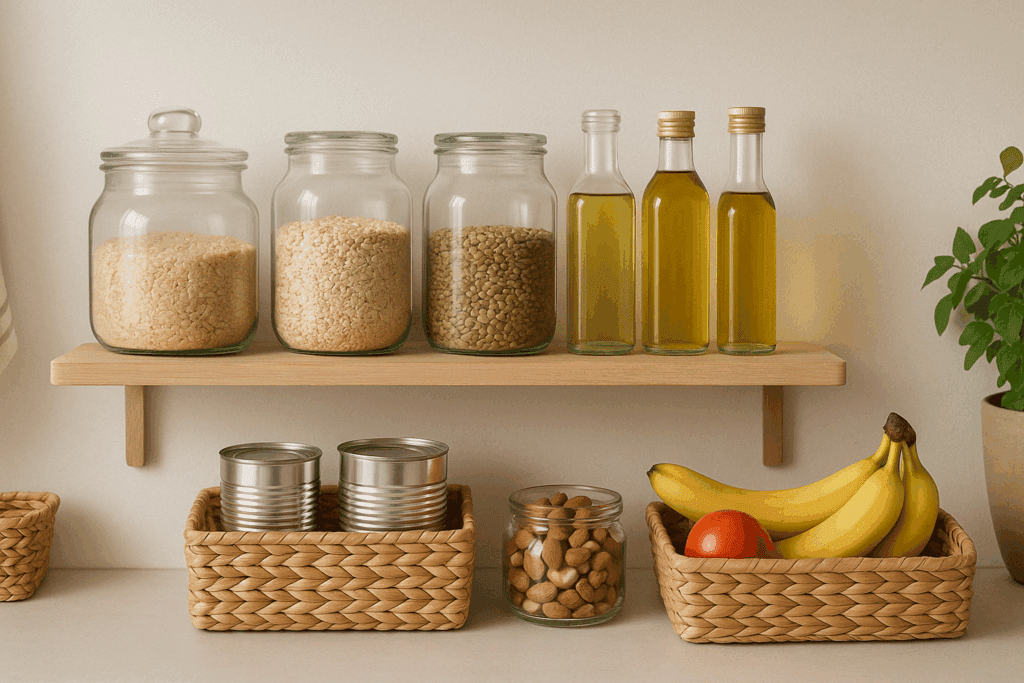
Creating a Sustainable Clean Eating Food List
Building a clean eating food list tailored to your lifestyle is one of the most effective ways to stay consistent. Rather than following a generic meal plan, create a list based on your preferences, dietary needs, cooking abilities, and cultural background. This list should include everyday staples like leafy greens, whole grains, eggs, legumes, and healthy oils, as well as convenient items such as frozen berries, unsweetened almond milk, or canned salmon.
To make clean eating practical, prioritize ingredients that are versatile and easy to use in multiple recipes. For example, quinoa can be used in salads, breakfast bowls, and stir-fries, while chickpeas work well in soups, curries, or as a roasted snack. Keep your kitchen stocked with clean basics that make quick, balanced meals possible even on busy days. Over time, this builds confidence in your ability to maintain a clean eating lifestyle without the need for constant planning or expensive specialty items.
Shopping for the cleanest foods may involve visiting local farmers’ markets or choosing organic produce when possible, but it doesn’t require a complete budget overhaul. Many clean eating foods—like oats, lentils, bananas, and carrots—are among the most affordable options available. The goal is not to buy the trendiest “health foods” but to choose whole, nutrient-rich items that work within your means and taste preferences.
Clean Eating and Long-Term Health Benefits
Clean eating is more than just a nutritional philosophy—it is a long-term investment in your health. Diets rich in clean eating foods have been associated with a reduced risk of numerous chronic diseases, including type 2 diabetes, heart disease, and certain cancers. The antioxidants found in fruits and vegetables protect cells from oxidative damage, while fiber from whole grains and legumes supports a healthy gut microbiome and stable blood sugar.
Research has shown that diets emphasizing whole foods and minimizing processed ingredients are also beneficial for mental health. Nutrients like omega-3 fatty acids, magnesium, B vitamins, and amino acids all play critical roles in mood regulation, cognition, and stress resilience. Clean eating supports brain health by ensuring consistent intake of these essential compounds without the added burden of inflammatory foods.
From a metabolic standpoint, clean eating may also improve insulin sensitivity, support healthy cholesterol levels, and aid in weight management. Unlike fad diets that encourage extreme restriction, clean eating provides a steady stream of energy and nourishment, which can help prevent binge eating and support better hormonal regulation. These outcomes are not the result of magical ingredients, but of consistently choosing foods that work in harmony with the body’s natural systems.
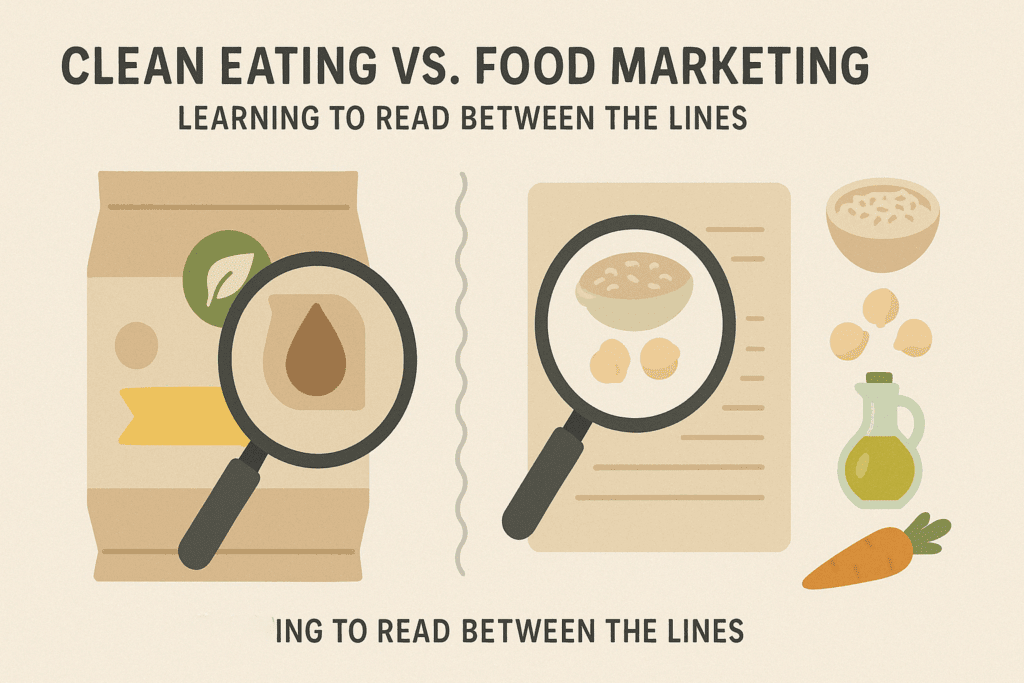
Clean Eating vs. Food Marketing: Learning to Read Between the Lines
One of the most empowering aspects of clean eating is learning how to see through misleading food marketing. Terms like “natural,” “light,” and “low-fat” are often used on packaging to give an impression of healthfulness, but they are not regulated in the same way as nutritional labels. A food that appears clean on the surface may still contain hidden sugars, synthetic additives, or ultra-processed ingredients.
When selecting clean eating foods, the ingredient list tells a more accurate story than the front of the package. Look for short, recognizable ingredients with no artificial colors, flavors, or sweeteners. Beware of “health halos” surrounding products labeled as vegan, gluten-free, or organic—they can still be highly processed or lacking in nutritional value. Clean eating requires critical thinking and a willingness to investigate beyond marketing claims.
This level of food literacy is part of what makes clean eating a long-term lifestyle rather than a temporary diet. It cultivates self-awareness and independence from food fads. When you understand the clean eating definition and apply it with discernment, you become your own best advocate for health. You no longer rely on trends or labels to dictate your choices—you choose based on evidence, experience, and personal well-being.
Frequently Asked Questions About Clean Eating
1. How can someone transition to clean eating without overhauling their entire lifestyle at once?
Transitioning to clean eating doesn’t require an overnight transformation. The most sustainable approach involves gradual integration of clean eating foods into your current diet. Start by identifying one meal each day—such as breakfast—that you can consistently make with whole ingredients like oats, berries, and unsweetened nut milk. Over time, replace processed pantry staples with items from a clean food list, such as switching white rice to quinoa or store-bought salad dressings to olive oil and lemon. This phased strategy reduces the feeling of deprivation and builds long-term habits aligned with clean eating meaning. By focusing on small, achievable steps, clean eating becomes a practical and empowering shift rather than a daunting obligation.
2. What role does emotional well-being play in maintaining a clean eating lifestyle?
Psychological resilience and emotional regulation are deeply intertwined with long-term success in clean eating. For many, emotional triggers—like stress, boredom, or fatigue—can lead to seeking comfort in highly processed foods. Incorporating clean eating foods that stabilize blood sugar, such as fiber-rich vegetables and healthy fats, can reduce mood swings and cravings. Moreover, viewing clean eating as a flexible, supportive practice rather than a rigid rulebook helps prevent guilt and fosters a healthier relationship with food. Emotional balance supports consistency, which is more valuable to health outcomes than sporadic bouts of perfection. Understanding what eating clean means emotionally—compassion, self-awareness, and adaptability—is just as important as knowing what to eat.
3. Are there cultural variations in what qualifies as clean food?
Absolutely. The concept of what clean food can and should reflect cultural dietary traditions. Clean eating isn’t confined to Western notions of nutrition—it can include traditional Indian dals, Mediterranean legumes, Japanese seaweed salads, or Ethiopian lentils. The key is focusing on whole, minimally processed ingredients common to each culture’s culinary roots. Incorporating cultural foods into your clean eating food list allows for greater diversity in nutrients and flavor profiles while supporting cultural heritage and identity. The clean eating definition should be inclusive, encouraging global dietary practices that prioritize nourishment without imposing one-size-fits-all standards.
4. How does clean eating impact athletic performance or physical endurance?
Clean eating provides the nutrient density required for optimal muscle recovery, cardiovascular efficiency, and sustained energy. Athletes or active individuals often benefit from emphasizing clean eating foods rich in complex carbohydrates—like sweet potatoes and brown rice—for energy, alongside protein sources such as lentils, tofu, or lean poultry for muscle repair. The cleanest foods for performance also include leafy greens and berries, which help combat oxidative stress from intense physical exertion. Those who follow a clean food list that prioritizes hydration and anti-inflammatory foods may notice quicker recovery times and improved stamina. Clean eating meaning, in the context of fitness, aligns closely with functional fuel rather than appearance-based goals.
5. Can clean eating support hormone health, particularly for women?
Yes, clean eating has a significant impact on hormone balance, especially for women. Certain clean eating foods—like flaxseeds, cruciferous vegetables, and avocados—support estrogen metabolism, progesterone balance, and adrenal function. Eliminating endocrine-disrupting additives found in many ultra-processed foods also reduces exposure to xenoestrogens, which can interfere with natural hormone function. A clean food list rich in phytonutrients, omega-3 fatty acids, and micronutrients like magnesium and B vitamins can be especially beneficial during menstruation, pregnancy, or menopause. When people ask what does eating clean mean for hormonal health, the answer lies in consistent nourishment with whole foods that minimize chemical interference and support endocrine resilience.
6. How can busy professionals follow clean eating without sacrificing time?
Time constraints are one of the biggest barriers to healthy eating, but clean eating doesn’t have to be time-intensive. Prepping a clean eating food list and batch-cooking key staples like quinoa, roasted vegetables, or lentil stews on weekends can make weekday meals simple and stress-free. Many clean eating foods also require little preparation—think pre-washed salad greens, canned chickpeas (rinsed and drained), or fruit with almond butter. Smart grocery shopping strategies, such as sticking to the perimeter of the store and avoiding marketing traps, save both time and decision fatigue. With a bit of organization, clean eating becomes a time-saving routine rather than a burden, especially when meals can be assembled quickly using a few high-quality ingredients.
7. Are frozen or canned foods compatible with clean eating?
Many people assume clean eating foods must be fresh and perishable, but that’s not always the case. Frozen fruits and vegetables are picked at peak ripeness and flash-frozen to preserve nutrients, making them excellent clean food options, especially in the off-season. Similarly, canned items like beans, tomatoes, or wild-caught fish can be clean—provided they’re free from additives like sodium benzoate or added sugar. Always check ingredient labels to ensure alignment with your clean eating food list. When properly selected, shelf-stable and frozen items add convenience and affordability to clean eating without compromising nutritional quality.
8. How does clean eating affect gut health and the microbiome?
The impact of clean eating on gut health is profound and well-documented. Clean eating foods such as fermented vegetables, legumes, and high-fiber fruits nourish beneficial gut bacteria, improving digestion and reducing inflammation. Many processed foods, in contrast, contain emulsifiers, added sugars, and synthetic chemicals that disrupt the gut barrier and contribute to microbial imbalance. By consistently choosing items from a clean food list, individuals can foster a diverse, resilient microbiome that supports immune function, brain health, and hormonal balance. The cleanest foods for gut health are often plant-based and rich in prebiotics—fibers that feed your internal ecosystem.
9. What are some signs you’re benefitting from a clean eating lifestyle?
Positive outcomes from clean eating often manifest gradually but are deeply impactful. Common signs include improved energy levels, better digestion, clearer skin, and more stable mood and blood sugar throughout the day. Individuals who embrace the clean eating meaning holistically often report fewer food cravings and more satisfaction with meals. Long-term, maintaining a personalized clean eating food list may also lead to reduced inflammation, enhanced sleep quality, and better metabolic markers such as cholesterol and blood pressure. These changes, though subtle at first, build over time and reinforce the sustainable benefits of prioritizing clean eating.
10. What’s the future of clean eating in public health and food policy?
As the clean eating movement gains scientific validation, its influence is extending beyond personal wellness into larger discussions about food systems and policy. Governments and health organizations are beginning to recognize the value of promoting clean eating foods in school lunches, community nutrition programs, and healthcare settings. Initiatives encouraging access to the cleanest foods—especially in underserved areas—are likely to increase, reflecting a broader commitment to preventative health. Food labeling standards may evolve to better define and regulate what is clean food, reducing consumer confusion. Ultimately, the clean eating definition is expected to play a growing role in shaping both individual habits and public health strategies, making it not just a lifestyle choice but a cornerstone of nutritional equity.
Conclusion: Clean Eating as a Foundation for Lifelong Wellness
Clean eating, when approached with knowledge and balance, can become a powerful framework for lifelong wellness. By understanding what clean food really means and learning to build a practical clean food list, individuals can navigate nutrition with confidence and clarity. The clean eating definition is not rigid or dogmatic—it’s rooted in science, mindfulness, and the pursuit of true nourishment. It focuses on real, whole foods that empower the body to thrive without reliance on restrictive rules or unrealistic goals.
Whether you’re just beginning or refining an existing routine, incorporating clean eating foods into your daily meals is a sustainable way to promote vitality and prevent disease. By asking yourself what eating clean means in the context of your life, and aligning your food choices with that vision, you lay the foundation for a more intentional and resilient relationship with nutrition.
Clean eating isn’t about being perfect. It’s about being informed. It’s about choosing the cleanest foods you can reasonably access and building habits that serve your body, your community, and your future. With time, patience, and curiosity, clean eating becomes more than just a habit—it becomes a way of life that honors your health, your values, and your potential.
Was this article helpful? Don’t let it stop with you. Share it right now with someone who needs to see it—whether it’s a friend, a colleague, or your whole network. And if staying ahead on this topic matters to you, subscribe to this publication for the most up-to-date information. You’ll get the latest insights delivered straight to you—no searching, no missing out.
Further Reading:
Clean Eating
Clean-Eating Foods List
11 Simple Ways to Focus on Whole Foods Instead of Clean Eating
Disclaimer
The information contained in this article is provided for general informational purposes only and is not intended to serve as medical, legal, or professional advice. While NewsHealthWatch strives to present accurate, up-to-date, and reliable content, no warranty or guarantee, expressed or implied, is made regarding the completeness, accuracy, or adequacy of the information provided. Readers are strongly advised to seek the guidance of a qualified healthcare provider or other relevant professionals before acting on any information contained in this article. NewsHealthWatch, its authors, editors, and contributors expressly disclaim any liability for any damages, losses, or consequences arising directly or indirectly from the use, interpretation, or reliance on any information presented herein. The views and opinions expressed in this article are those of the author(s) and do not necessarily reflect the official policies or positions of NewsHealthWatch.

